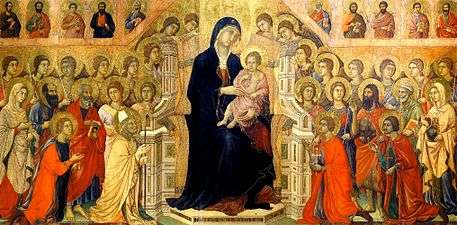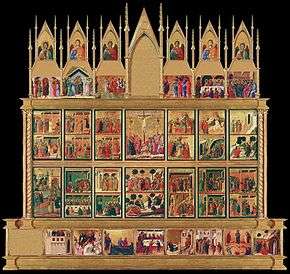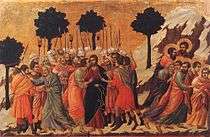Maestà (Duccio)
The Maestà, or Maestà of Duccio is an altarpiece composed of many individual paintings commissioned by the city of Siena in 1308 from the artist Duccio di Buoninsegna[1] and is his most famous work.[2] The front panels make up a large enthroned Madonna and Child with saints and angels, and a predella of the Childhood of Christ with prophets. The reverse has the rest of a combined cycle of the Life of the Virgin and the Life of Christ in a total of forty-three small scenes; several panels are now dispersed or lost. The base of the panel has an inscription that reads (in translation): "Holy Mother of God, be thou the cause of peace for Siena and life to Duccio because he painted thee thus." [3] Though it took a generation for its effect truly to be felt, Duccio's Maestà set Italian painting on a course leading away from the hieratic representations of Byzantine art towards more direct presentations of reality.
| Maestà | |
|---|---|
 | |
| Artist | Duccio di Buoninsegna |
| Year | 1308–1311 |
| Type | Tempera and gold on wood |
| Dimensions | 213 cm × 396 cm (84 in × 156 in) |
| Location | Museo dell'Opera Metropolitana del Duomo, Siena |
History
Duccio di Buoninsegna painted the work with assistants in a studio located on Via Stalloreggi, very close to the Duomo di Siena. The painting was installed in the cathedral of Siena on 9 June 1312 after a procession of the work in a loop around the city. One person who witnessed this event wrote:
And on that day when it was brought into the cathedral, all workshops remained closed, and the bishop commanded a great host of devoted priests and monks to file past in solemn procession. This was accompanied by all the high officers of the Commune and by all the people; all honorable citizens of Siena surrounded said panel with candles held in their hands, and women and children followed humbly behind. They accompanied the panel amidst the glorious pealing of bells after a solemn procession on the Piazza del Campo into the very cathedral; and all this out of reverence for the costly panel… The poor received many alms, and we prayed to the Holy Mother of God, our patron saint, that she might in her infinite mercy preserve this our city of Siena from every misfortune, traitor or enemy.
Besides the Virgin Mary and the Baby Jesus, saints depicted in the painting include John the Evangelist (to the left of the throne); Saint Paul; Catherine of Alexandria; John the Baptist (to the right of the throne); Saint Peter; Mary Magdalene, and Saint Agnes.[4] In the foreground are Siena's various patron saints: Saint Ansanus; Saint Sabinus; Saint Crescentius; and Saint Victor.[4]
Creating this altarpiece assembled from many wood panels bonded together before painting was an arduous undertaking. The work was not only large, the central panel was 7 by 13 feet, but it had to be painted on both sides since it could be seen from all directions when installed on the main altar at the centre of the sanctuary.[5]
Dismantling and current locations
The altarpiece remained in place until 1711, when it was dismantled in order to distribute the pieces between two altars. The five-metre high construction was dismantled and sawn up, and the paintings damaged in the process. Partial restoration took place in 1956. The dismantling also led to pieces going astray, either being sold, or simply unaccounted for. Extant remains of the altarpiece not at Siena are divided among several other museums in Europe and the United States.
The panels in Siena are housed in the Duomo museum adjacent to the Duomo di Siena. The central panel, lower panels, and rear are displayed separately in the same room.
Stylistic analysis
- Deposition
Christ's followers, Joseph and John, remove him from the cross while Nicodemus removes nails from his feet. The Virgin Mary looks into his closed eyes while Mary Magdalene holds his arm, and all have painful expressions as they tend to the dead Christ. The background has the same gold texture as in the "Crucifixion" and the cross that held Christ has blood running onto the ground, increasing the sense of realism in the scene. This panel aroused the emotions of its audiences and the story helped to symbolize the birth of Christianity.
- Burial
Immediately following the "Deposition," is the depiction of Christ as he is prepared for burial, surrounded by his mourning followers. His mother leans in close to him and kisses him one last time and Mary Magdalene throws her arms towards the sky in anguish. The background retains the gold setting of the "Deposition" and "Crucifixion," and the mountains in the background are similar to the mountains portrayed in previous and subsequent panels. These mountains lead the viewer's eye to Mary who is accompanying him, and then to Christ's face. This scene also elicits an intense emotional response from its viewers and you can see the close connection that the burial party has to Christ, and especially to the Virgin Mary.
List of panels in the world
In Siena


- The Mother of God Enthroned with the Christ Child Amidst Angels and Saints, central panel
- The Wedding Feast of Cana
- The Temptation of Christ atop the Temple
- The Annunciation of the Virgin's death
- The Virgin's Farewell to St. John
- The Virgin's Farewell to the Apostles
- The Death of the Virgin
- The Funeral of the Virgin
- The Burial of the Virgin
- The Appearance of Christ behind closed doors
- The Incredulity of St. Thomas
- The Pentecost
- The Appearance of Christ on Lake Tiberias
- The Appearance of Christ on the Mountain in Galilee
- The Appearance of Christ to the Apostles at Supper
- The Adoration of the Magi; Solomon
- The Presentation in the Temple; the prophet Malachi
- The Massacre of the Innocents; the prophet Jeremiah
- The Flight into Egypt; the prophet Hosea
- The Boy Jesus among the Doctors
- Episodes from Christ's Passion Tempera and gold on wood. The work, consisting of 26 episodes on 14 panels, was originally the reverse surface of the Maestà.
Elsewhere
Europe
- Angel (formerly in the Stoclet Collection, Brussels)
- The Annunciation (National Gallery, London)
- Archangel Gabriel (Castel Huis Bergh, in 's-Heerenberg, The Netherlands)
- Christ and the Samaritan Woman (Museo Thyssen-Bornemisza, Madrid)
- The Coronation of the Virgin (Szépmüveszéti Muzeum, Budapest – image)
- Healing of the Blind Man (National Gallery, London)
- The Transfiguration (National Gallery, London)
United States
- Angel (Philadelphia Museum of Art, Philadelphia)
- Angel (Mount Holyoke College, South Hadley, Massachusetts)
- Isaiah; Nativity; Ezekiel (Andrew W. Mellon Collection, National Gallery of Art, Washington, DC)
- Temptation of Christ on the Mountain (Frick Collection, New York)
- Calling of SS. Peter and Andrew (Samuel H. Kress Collection, National Gallery of Art, Washington DC)
- The Raising of Lazarus (Kimbell Art Museum, Fort Worth, Texas)
See also
References
 | ||||
- Medieval Italy: An Encyclopedia by Christopher Kleinhenz (Nov 2003) Routledge, ISBN 0415939305 page 310
- Encyclopedia Britannica: Duccio
- "Art History: Fourteenth to Seventeenth Century Art" by Marilyn Stokstad (2011) page 543
- The Maestà by Duccio di Buoninsegna – Olga's Gallery
- Stockstad, Marilyn. Art History, 2011, 4th ed., ISBN 0-205-79094-1
- "Duccio's Maesta (front)". Smarthistory at Khan Academy. Retrieved 31 January 2013.
- "Duccio's Maesta (back)". Smarthistory at Khan Academy. Retrieved 24 January 2013.
Further reading
- Stubblebine, James H. (1973). "Duccio and His Collaborators on the Cathedral Maestà". The Art Bulletin. 55 (2): 185–204. doi:10.1080/00043079.1973.10789738.
- Bellosi, Luciano (1999). Duccio: The Maestà. New York: Thames and Hudson. ISBN 978-0500237717.
- Ragioneri, Giovanna (1989). Duccio. Florence: Cantini. ISBN 88-7737-058-0.
External links
| Wikimedia Commons has media related to Cathedral (Siena) - Maestà. |
- Article giving diagrams of the structure and images of the pieces
- Carl Brandon Strehlke, "Archangel by the Workshop of Duccio di Buoninsegna (cat. 88)," in The John G. Johnson Catalogue: A History and Selected Works, a Philadelphia Museum of Art free digital publication.